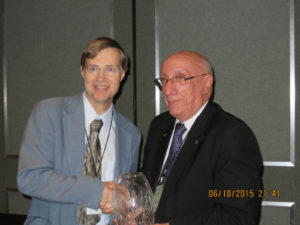
The ASTM D35 Committee on Geosynthetics had a successful series of meetings in Anaheim, Calif., June 17–19, 2015. The highlight at this biannual gathering was the presentation of the L. David Suits Award to Tony Allen of the Washington State Department of Transportation for his enormous contributions to the geosynthetics industry. His work in soil reinforcement has driven the need within ASTM D35 to develop greater knowledge on geosynthetic materials and standardization for their proper applications.
The D35.01 Subcommittee on Mechanical Properties was active during the Anaheim meetings with emphasis on both existing and developing test procedures. Wide-width tensile test procedures were discussed with regard to updating the pre-load instructions and deciding that the occasional practice of summing measured tensile results for a calculated ultimate tensile strength would be left to users of the test and not included in the procedure details. While celebrating the updated ASTM D7737 junction strength test procedure, new work was initiated on low-strain junction modulus, a measurement relevant to geosynthetic reinforcement of road bases. Brian Wedin of Presto Products showed some early work on geocell standards and we anticipate ballot activity for these relatively nonstandardized materials. Finally, a large audience participated in robust consideration of a new standard for MARV (minimum average roll value) and geosynthetic manufacturer certification for MARV. Discussion centered on the minimum time to be associated with production experience associated with a published MARV.
For the D35.02 Subcommittee on Endurance Properties, four standards were reviewed. D4873-15 “Standard Guide for Identification, Storage, and Handling of Geosynthetic Rolls and Samples,” where specific information was added to cover geogrids, geomembranes, geonets, and geocomposites. Work is being done in this task group to include rolled erosion control products. Technical improvements were made to standards D5496 “Standard Practice for In-Field Immersion Testing of Geosynthetics,” D5885 “Standard Test Method for Oxidative Induction Time of Polyolefin Geosynthetics by High-Pressure Differential Scanning Calorimetry,” and D7409 “Standard Test Method for Carboxyl End Group Content of Polyethylene Terephthalate (PET) Yarns.”
The D35.03 Subcommittee on Permeability and Filtration discussions continued on in an effort to resolve the issue concerning the shape or tortuosity factor that is plugged into the porometer prior to running the bubble point test. As explained at a meeting at Syracuse University in May, this factor is determined based on the shape of the pores of the material. At the May meeting, it was explained that a factor of 0.715 was a good average for oblong and rectangular pore shapes. Square or round shapes have a factor of 1. At the Anaheim meeting it was agreed to use the factor of 1 for materials that are known to have square or round pore shapes, and 0.715 for other known shapes. The question whether a correction factor should be applied to the test data in computing AOS (apparent opening size) remains. It was decided to re-examine existing data for the various types in an effort to address this question.
The D35.04 Subcommittee on Geosynthetic Clay Liners (GCLs) reviewed current ASTM GCL standards and to edit these as requested.
The ASTM D5891 standard, “Fluid Loss Index Test for Bentonite,” was discussed in detail to improve the precision of the tests between labs. It was discovered that the current description of bentonite drying was not described in detail and changes will be balloted. Further, a checklist will be added to the test standard to improve communication.
ASTM D6495 “Standard Guide for Acceptance Testing Requirements for Geosynthetic Clay Liners” was already revised and multi-component GCLs were added in the latest version. Now the ASTM D5888 “Standard Practice for Quality Control of Geosynthetic Clay Liners” is being modified and test procedures as well as recommended test frequencies are being added for multicomponent GCLs. The hydraulic properties of GCLs are covered in two standards (D5889 and D6766) and both are under revision. The main topics of discussion are the adjustment to the CEN EN standard 16416, where the reporting temperature is 10°C rather than 20°C as stated in the ASTM standard.
The D35.05 Subcommittee on Geosynthetics in Erosion and Sediment Control focused on:
- updating the sampling/specimen preparation procedures in the most commonly used rolled erosion control (RECP) index tests.
- clarifying the apparatus details and testing procedures used in conducting both light penetration and flexibility testing.
- revising two proposed standards on geosynthetic concrete composite mats (GCCM) that went through subcommittee ballot this spring to address the negatives received. The proposed standards are for sample and specimen preparation and for flexural strength testing.
Additionally, a specification for turf reinforcement mats (TRMs) being developed by the Erosion Control Technology Council (ECTC) was reviewed and two new test methods were proposed and approved for further development. The proposed test methods are:
1. Test method to look at the horizontal permeability of sediment retention devices (SRDs).
2. Test method to quantify the “functional longevity” of RECPs and SRDs.
Within the meeting of D35.10 Subcommittee on Geomembranes, a task group focusing on the characterization of multi-component geomembranes was initiated as a joined effort between D35.02 on Durability, and D35.10 on Geomembranes. Several methods commonly used to characterize polyolefin geomembranes will be revisited to address technical issues that are specific to these materials: white or colored geomembranes, ethylene vinyl alcohol (EVOH) core, conductive, or any other geomembrane structure that includes one or multiple layers with a composition that differs from the core. The standards that will be revisited include density, carbon black content, carbon black dispersion, National Certified Testing Laboratories (NCTL), oxidative induction time (OIT), and high-pressure oxidative induction time (HP-OIT).
ASTM D35 Committee’s next meeting is in San Antonio, Texas, Jan. 27–29, 2016.
 TEXTILES.ORG
TEXTILES.ORG


